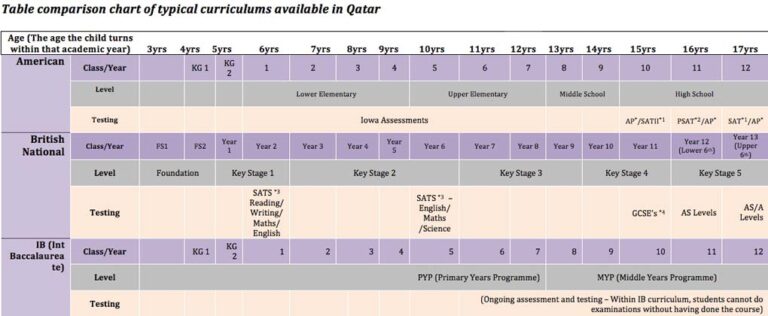Life as an expat can open doors to an international framework of education that whilst improving our children’s opportunities, can also confuse us parents. Whilst we all scramble for the best school place possible, we are faced with an additional challenge of choosing the right curriculum for our kids. Though this decision is often made for us by the system set within our home country, some parents find their home curriculum unavailable (e.g. Australian and New Zealand) and so a curriculum choice may not obvious.
How different are the curriculums?
Within the primary school years, the differences between curricula appear minor, but upon reaching secondary school, students can find considerable differences once they are introduced to exams and subject selection. This is especially important to consider when transitioning between curricula in later education. For example, some countries’ education authorities, e.g. Dubai’s Education Board, Knowledge and Human Development Authority (KHDA), believes that the American curriculum is one year behind the British National curriculum and therefore requires students to go down a year when moving to the latter.
While Qatar’s Supreme Education Council (SEC) has not directly addressed the difference between these two curricula, it is something to keep in mind, particularly if Qatar is not your last expat station as it can make moving from the American curriculum back to the British curriculum especially difficult, if at all possible.

International baccalaureate (IB)
The IB curriculum, founded in 1968, is independent of government and national systems. It is attempting to bridge the gap by offering four age-based programmes that focus on developing internationally minded students. Because the IB curriculum requires the students to have undertaken every aspect of coursework with ongoing assessment in addition to regular exams, it is not easy to move to an IB curriculum within the MYP (Middle Years Programme 11-16yrs) as students would have missed the required amount of hours and necessary coursework completion stages. Also, because of the way IB makes assessments, if a child is weak in one subject, it will bring down their overall mark and doesn’t easily allow for highlighting specific grade successes as university application is based on a singular final score.
British and American systems
Whilst the British system focuses on subject-specific examination stages, American and IB systems students study a comprehensive range of subjects right till the end of secondary/high school. This means that American and IB systems students can wait until they are 18 years of age before deciding on a career and university education path. However, if they intend on attending a U.K. university, they may find that the course prerequisites require students to have studied certain subjects (e.g physics, biology and chemistry) more extensively than the IB or American system allow.
New to Doha: the Finnish system
With the recent opening of Qatar’s first Finnish school, we mustn’t overlook the remarkable differences this curriculum offers. In Finland, the state decides what children should learn, but not how they should learn it. So, for example, if it suits the children to go out into the woods and count trees and twigs, they do. As teachers are typically assigned to the same students each year, they move through the curriculum with their class , allowing the teachers to understand each child’s needs and better tailor their teaching methods.
The table below shows the terminology typically used in Qatar to refer to the classes, learning stages and exam testing of each of the top three most commonly available curriculums.
In order to grasp the differences within the American, British and IB curriculums it is also important to note a few points:
• ‘Year’ or ‘class’ is used in the U.K. to describe a student’s ‘grade.’
• The U.K. term ‘public schools’ refers to ‘independent’ (privately-funded) schools.
• ‘College’ in the U.K. refers to the final two years of secondary school, while ‘university’ refers to undergraduate and postgraduate study.

Advanced Placement
Scholastic Assessment Test
Preliminary Scholastic Aptitude Test
Standard Assessment Tests
General Certificate of Secondary Education
Making the decision
Selecting a curriculum can be as much a personal as well as a practical decision.
With the lack of an Australian curriculum available in Qatar, Mary Jones* said, “As an Australian teacher I would stick with IB as it also an inquiry-based curriculum. While IB is the closest curriculum in Doha [to the Australian system], it also matters whether it is a “good” school.” However, Haifa Yat, prefers the British curriculum; “I would always choose the British curriculum as it’s close to the Australian curriculum and the children wouldn’t feel a huge difference settling back into the education system.”
With the British National Curriculum, developed in detail through U.K. government, many feel it to be overly aligned with the political vision for the government, while it intends to top the most rigorous of curriculums worldwide.
Regarding the American curriculum, whilst the U.S. Department of Education does exist, establishing curriculum is not in its mission. This means that internationally located American schools are left to decide how to build their curriculum. Therefore, topics, programming and quality can vary widely among schools that are based on the American curriculum.
Luckily, universities and colleges across the U.S., Europe and Asia are also becoming much more knowledgeable and accepting of students with differing exam curriculums.
A few important questions to ask oneself when choosing a curriculum:
• How long do we plan on staying in the country?
• What is the next country/education system we are likely to move to?
• What kind of future do I want for my children? Are they old enough to make career choices yet, e.g. a particular university in a specific country versus practical career development?
• Does the learning/testing method of this curriculum suit my child?
As parents, we are always striving for the best for our children and whilst a curriculum goes a long way to defining their future career paths, the school itself obviously plays a prominent part in our children’s educational growth. In addition to the school’s curriculum, teaching philosophies and techniques, resources and individual attention are some of the most important aspects to consider when selecting a school for your children.
*Some names have been changed for privacy.



